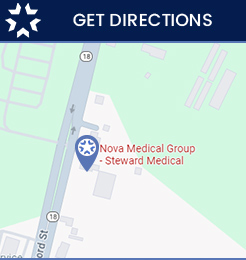Fracture Treatment Specialist in East Bridgewater, MA
A bone fracture happens when something strikes your bone with enough force to not only cause harm but also break it in at least one spot. Symptoms include sharp pain, swelling, and difficulty utilizing or moving the damaged area. At Nova Medical Group in East Bridgewater, MA Dr. Akash Patel, MD, a board-certified physician, provide comprehensive treatment for broken bones and various other injuries. If you suspect you’ve broken a bone, avoid delaying getting professional care because it could lead to serious complications that disrupt your everyday life. For more information, contact us today or book an appointment online. We are located at 401 N Bedford St, East Bridgewater, MA 02333.


Table of Contents:
What are fractures?
What are the types of fractures?
How is a simple fracture treated?
How long does it take for the fracture to heal?
Fractures are one of the most common injuries that occur and can happen to people of any age. There are some factors that can increase your risk of fracturing a bone, so if you are at an increased risk, it is worth speaking with a health care provider to know how best to avoid incurring a fracture wherever possible.
A fracture is just another term for a broken bone, encompassing several types of fractures that can occur due to traumas such as car accidents, falls, or sports injuries, or repetitive motions that slowly cause the break. A fracture can be differentiated from a bone bruise based on how much damage has been done, as it is possible for the bone to become bruised and to bleed without being broken. Fractures will often take longer to heal than bone bruises and are considered to be a more severe injury. Common symptoms associated with fractures include swelling, pain, tenderness, the development of an abnormal bump, visible bruising and discoloration, and an inability to move the injured body part normally. Fractures can often be diagnosed through a physical examination and diagnostic imaging such as an X-Ray, CT scan, or MRI.
There are several different types of fractures that can be classified by pattern, cause, or location. Fracture classifications by pattern or shape include oblique fractures, transverse fractures, and longitudinal fractures (which are all in a straight line), as well as greenstick fractures (a crack in the bone that does not extend all the way through the bone, only a partial break), comminuted or segmental fractures (more than one break within the same bone, more common following serious car accidents), and spiral fractures (occur when the bone breaks due to a twisting motion). Three common types of fractures that are classified by their cause include stress fractures, avulsion fractures, and buckle fractures. These types of fractures can then be further classified depending on which bone has incurred the injury to ensure that diagnosis and treatment are accurate. Additionally, fractures can be classified as either simple or compound, with simple fractures including all fractures that occur without breaking the surface of the skin and compound fractures including all fractures that do break the skin, leaving part of the bone exposed.
The exact course of treatment that is required to ensure that a simple fracture is able to heal properly depends on the placement and severity of the fracture. There are a few less likely cases where a minor fracture is able to heal entirely on its own, but these cases are quite rare. Most of the time, patients will need to have a cast placed over the broken bone to ensure that the injury does not worsen while the bone is trying to heal itself. It is also possible that more severe fractures will require a surgical procedure to set the bone in place using pins, rods, screws, or plates to help the bone to heal properly. Fractures that occur in the smaller bones such as the toes or fingers will likely only have a splint placed to keep the bone and surrounding joints immobilized throughout the healing process. Typically, if a fracture is more severe, it is more likely to require surgery and a longer period of time spent wearing the case to ensure proper treatment and healing.
On average, it takes around 6 to 8 weeks for a bone fracture to heal, but this timeline varies quite a bit depending on the type and severity of the fracture, the treatment method that is used for the fracture, as well as the overall health of the patient being treated. Most patients can expect to be able to start using their broken bone again within several weeks, but the severe cases may not see their bone heal even after a year following the injury. There are some unlikely but serious complications that are associated with bone fracture treatment, so the timeline and treatment plan may vary a bit from patient to patient in order to prevent and lower the risk of these complications as much as possible. Your physician will be able to outline a more accurate treatment plan along with the anticipated timeline throughout the treatment of your fracture.
If you suspect you have a broken bone, seek medical attention right away at Nova Medical Group. For more information, contact us today or book an appointment online. We are located at 401 N Bedford St, East Bridgewater, MA 02333. We serve patients from East Bridgewater MA, Abington MA, Brockton MA, West Bridgewater MA, Easton MA, Taunton MA, Raynham MA, and surrounding areas.


Additional Services You May Need
▸ Urgent Care
▸ Primary Care
▸ Women’s Health
▸ Weight Management
▸ Diabetes Management
▸ High Blood Pressure
▸ Xray/Lab
▸ Sports Medicine
▸ Specialty Services
▸ Occupational Health
▸ Adult Primary Care
▸ Pediatric Primary Care
▸ Geriatric Primary Care
▸ Fractures/Burns/Cuts
▸ Annual Physicals
▸ Hereditary Cancer Risk





